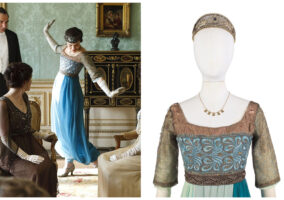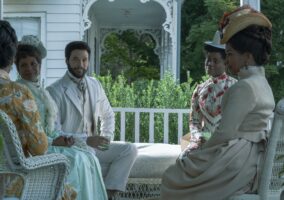Zip yourselves up and let’s get to it. We’ve got a lot of ground to cover.

Could there possibly have been a more shocking way to reintroduce Betty? Did you gasp like we did? The combination of the bejeweled cuffs and collar (very much in style for the older crowd at this time), the bracelets and prominent earrings, and that utterly ridiculous and unflattering hairstyle combine to make Betty look like a pampered poodle. Note the look of utter disgust on Sally’s face. Lots of mother/daughter history there revolving around weight and body issues. If Betty raised Sally to avoid weight gain like the plague (as she herself was raised by her mother), then it stands to reason that Sally isn’t going to be kind or understanding about it.
This is our first real glimpse of the Francis house and like all the other shots, it’s dark and old-fashioned.
Note the periwinkle color of Betty’s dress as well as the swirling paisley pattern. Why should you note this?
Because:

The current Mrs. Draper has no problem getting zipped into her dress, which is far more youthful and modern than Betty’s (dig that dropped waist and pleated skirt combo), but still calls back to it via the use of similar colors and similarly intricate patterns. Interesting to note that Betty’s in a swirly paisley and Megan’s in a more geometric, Aztec-like print; the WASP vs. the ethnic French-speaking girl.

We almost feel bad making so many comparisons between the two Mrs. Drapers, but these scenes were designed that way. Don hasn’t had a business dinner partner since Betty, so it’s natural to notice how Megan does in comparison. She’s similarly nervous, but unlike Betty, she can introduce topics into the conversation and pivot away from something she wished she hadn’t said (“Don was divorced,” meaning “I’m not a homewrecker.”).
The Heinz lady, ironically, looks like she could actually be Betty in about 20 years. The styles are roughly similar, which should give you some idea of how matronly Betty’s clothes are. Society saw little difference between a married woman in her 30s and a married woman in her 50s. They did the job expected of them and now they’re expected to quietly decline.
Megan is once again wearing the absolute latest in styles. This is not how everyone in her generation dresses right now, but about half her generation will be sporting these styles (the big, complicated hair, the massive jewelry, the wild prints) within a year. 1966 was when these styles were born, but it was ’67 and ’68 when they actually exploded all over the place.

Every inch the good girl, doing her job and not making waves. The dress is serviceable, but not overly stylish and the makeup is so low key that we’re not even sure if she’s wearing any. It wouldn’t be unheard of for her to think she needs to keep her nose to the grindstone and her head down if she wants to keep this job. Her general look reflects that. Interesting to note the earrings, though. They’re fairly prominent in an otherwise unadorned look and they’re not like any earrings any of the white female characters have been sporting up until now. It’s a nicely subtle way of signalling her cultural otherness without going overboard.

Mama Francis, like many women her age, station, and size, simply goes to her dressmaker and has the same dress made she’s been wearing for the past 35 years. And why not? Certainly that hairstyle hasn’t changed since the Depression.
And speaking of depression, here’s Betty, embodying the concept in her stiff, scratchy nylon bathrobe. There’s not a lot of tying the characters to their surroundings in any of the scenes in Betty’s house. No matching the dresses to the color scheme or anything like that. That was probably partially intentional because most of the house scenes are shot in such a way as to make the characters look like tiny little figures in a massive, dark room. No one really belongs in a house like this.

Peggy, once again working that combination of menswear and Catholic school uniform.

Again, the costuming here gives the effect of being pampered, childlike, and a bit ridiculous. As Mama Francis once said of her, “She’s a silly woman.” We don’t actually subscribe to such a harsh assessment, but Betty can be trivial and childish, certainly. Her clothes often reflect that. And while she wasn’t being silly in this scene, she was being quite reliant on someone else to be strong for her.

Here’s the thing about the Francis house: to 2012 eyes it looks pretty fantastic, if a little dark. That’s not how such a house would have been viewed during this period. Refurbished Victorian mansions were not what the average housewife wanted to live in. The suburban dream was still alive and well during this period and we can’t imagine that Betty’s really happy living in that kind of a house. Think of The Addams Family and The Munsters. Or Psycho. Big old houses like this were not seen as desirable; they were seen as horribly old-fashioned to the point of seeming sinister. We might want to live in that house in 2012, but it’s a safe bet that Betty didn’t want to in 1966, no matter how wealthy it made her seem. She’s traditional, but she’s not that traditional.

You want a shock? Check out the last time we saw Betty wearing blue roses. As we said in last week’s Mad Style, there’s an overwhelming sense of decline in this period for Americans. A lot of that is being referenced in the clothing and art direction.

Her friend’s outfit is perfectly suburban-mom appropriate and serves to not take too much focus away from Betty in the scene. You could argue, if you really want to get into the weeds (pun sort of intended), that Betty’s clothes reflect someone who’s still clinging to life and her friend’s serviceable but colorless getup reflect someone who’s in the process of letting go.
The fortune teller just represents fortune tellers. It’s a costume for this woman – and quite a silly one. Note that it’s trying to reference what would have been called gypsies at the time, except it’s completely devoid of any cultural markers or reference points. It’s just a scarf, a coat in a wild print, and everything she had in her jewelry box.

Okay, let’s start with this:
Peggy: white shirt, gold skirt.
Michael: white shirt, patterned tie with gold elements.
Think we’re stretching it? Are you saying, “Come on, guys. There are a lot of colors in that tie?”
Check it:

There are points being made about these characters through their clothing. Michael Ginsberg is a male Peggy Olson. He’s socially awkward, sloppily dressed, and extremely talented.
Although we have to say, it’s highly unlikely that his showing up for a job interview in a faded pair of ill-fitting jeans would have gone unremarked-upon. Yes, SCDP, like a lot of agencies at the time, valued their creative people and gave them some leeway, but this is probably pushing it on the believability front. Although it does a very nice job of underlining just how inappropriate Michael is.
Oh, and it’s a brilliant touch to have the sleeves on the jacket too short. He’s probably had that jacket since his Bar Mitzvah.

Two things jumped out at us here. The first is that she’s shot in a manner very similar to Betty’s scenes where she’s tiny in a huge room. Secondly, she’s dressed very much like we probably expected Betty to be dressing by this time. It’s a simple, clean look and it’s very similar to the more casual styles Betty was sporting a couple years ago. Very appropriate for a scene where Don’s going out and she’s staying home like a good wife.

What we loved most about the costuming for these backstage scenes is that none of these kids are dressed in wild, proto-hippy styles. That’s due partially to the fact that they really haven’t started yet and also because these are typical suburban kids. In fact, it’s kind of brilliant, because if you look around the room, most of them are wearing good-girl or good-boy clothes, with one wild element tacked onto it after they left the house and got away from their parents; a vest, or a pair of big earrings, or a long necklace. And if you couldn’t manage any of those, then just slip your bra strap down so it’s visible and gives you that hard edge that you so desperately want in order to impress Mick Jagger so he’ll ask you to marry him.

As always, Megan is dressed to showcase her sunny attitude and optimism, even in a scene where she has to be a little stern. The only thing truly notable about this is that she’s dressed this way in the city, rather than waiting to get out to Fire Island. That’s fairly racy on her part; that she would walk through the lobby of this building in a bikini top.

It’s killing us. How on earth can they afford such a massive house? Wasn’t it established that he didn’t have as much money as Don?

BALL-FRINGE, BETTY? Oh, how the mighty have fallen. Ball fringe on the cuffs, once again making her look fairly silly. It’s also notable how cheap her clothes look in this episode. Clearly, they’re not lacking for money, but plus-sized women of the period had even fewer clothing options than they do now. Granted, Betty could have her clothes made, but she really wouldn’t be able to face the measuring and fitting process with her current body.
Yes, that house is beautiful but it’s shot to look like a massive mausoleum. There’s a way to shoot old houses like this in order to make them look beautiful. Check out Downton Abbey for a primer on it. Clearly, the goal here was not to make the house look beautiful, but to make it look oppressive and to make Betty look insignificant inside it.

And of course, in a scene where Don says to her, “You’re such an optimist,” she’s once again in a sunny, optimistic yellow. Look how much she stands out in a crowd. This is another well-made and probably expensive outfit, but it’s not as showy as some of her others. That tousled bubble ‘do was very much in vogue and not a hairstyle that’s aged well. She and Don are both a little sunburned from their weekend on Fire Island.

Check out the bathtub with the board on it. Many typical Lower East Side flats had the bathtub in the kitchen and the window in the wall.
Despite the seeming acceptance and affection from his father, Michael Ginsberg IS Peggy Olson. From lighting to art direction, this scene mirrors the one from Season 2 where we met Peggy’s family for the first time:

We’re not sure why they’re signalling it so hard, especially when the dialogue more than made the point, but it served as a wonderfully subtle callback. Obviously, Michael comes from a poorer background, but there’s still that sense of claustrophobia and darkness; that sense of family members who don’t quite get what they’re doing.

From one kitchen to another; where the parent-child relationships couldn’t be more different. We were struck by how formal this scene is, right down to the parfait glasses. 1930s-style kitchens are all the rage now, but you can bet this is NOT the kitchen Betty wanted for herself. In fact, she mentioned last season that she would have to tear the kitchen out. She’s so affectless and listless that we imagine she can’t be bothered to even try to make this home her own. Contrast that with the aggressive home decorating she was doing back in Ossining, when it was a house that mattered to her.
Oh, Betty. Ditch the ball fringe and rip out that kitchen for a gleaming space age wonder. You’ll regret it come 1980, when refurbishing old houses will be all the rage, but at least you won’t be sitting in a tomb all day.
[Screencaps: tomandlorenzo.com]
Smash: Hell on Earth Next Post:
Mad Men: Mystery Date
Please review our Community Guidelines before posting a comment. Thank you!



